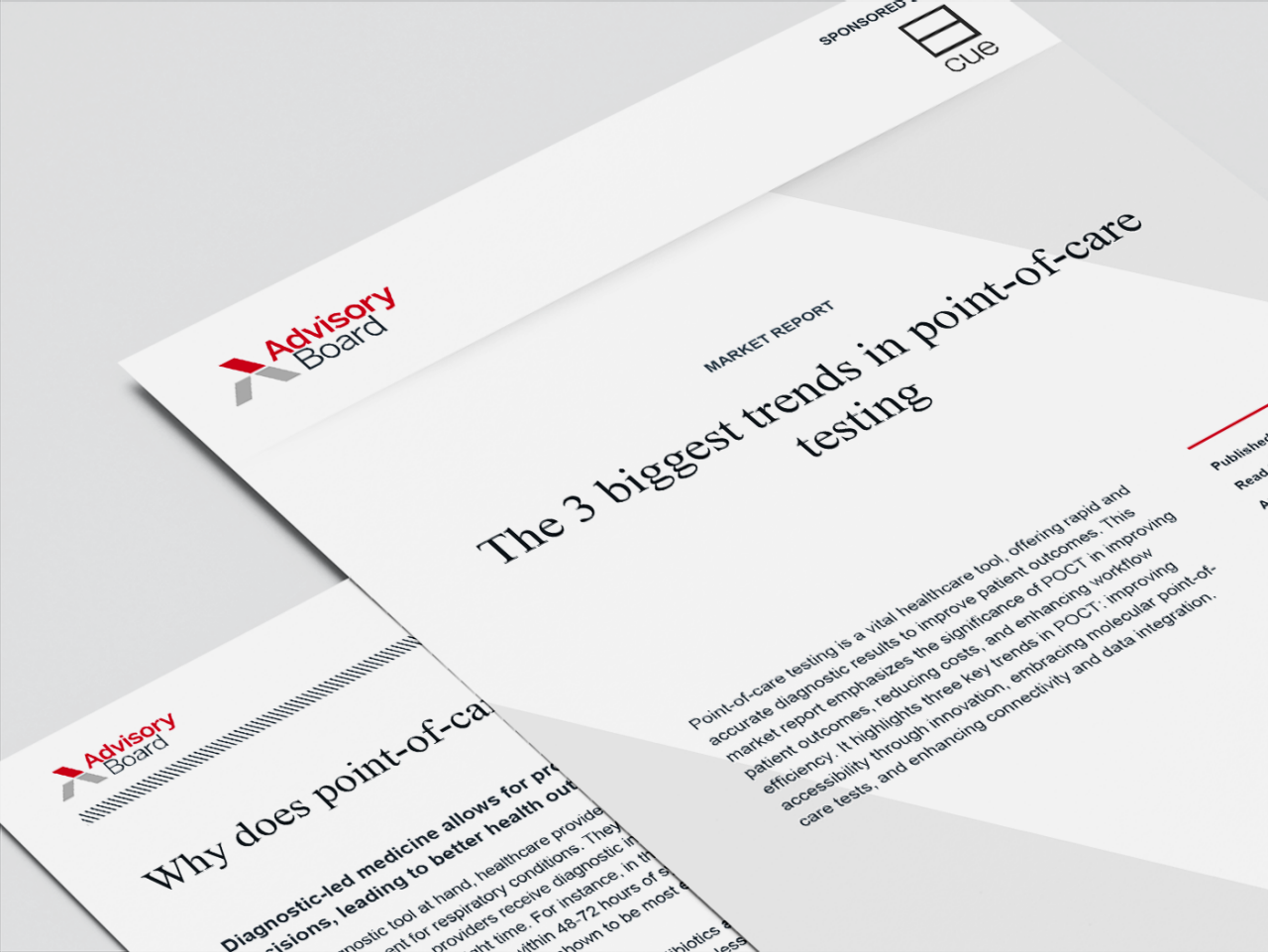Auto logout in seconds.
Continue LogoutPoint-of-care testing (POCT) refers to diagnostic tests performed near the patient at the point-of-care, such as in hospitals, clinics, urgent care, or independent practices. These tests are conducted "then and there," providing immediate results to healthcare professionals. POCT is also known as on-site testing, as it eliminates the need to send samples to a centralized laboratory for analysis.
One of the key aspects of POCT is the variation in methods used for sample collection and analysis. Different tests may utilize molecular or antigen-based techniques, which can impact the specificity and sensitivity of the results. Molecular tests, such as nucleic acid amplification tests (NAAT), detect the genetic material of the pathogen, while antigen tests identify specific proteins on the surface of the pathogen.
One of the most common uses for POCT is diagnosing respiratory viruses. According to Cue Health CMO Dr. David Tsay, the COVID-19 pandemic has significantly increased public awareness and familiarity with POCT, particularly with at-home tests for COVID-19. These tests allow individuals to collect their own samples and perform the test in the comfort of their own homes, providing results within a short period of time.
Diagnostic-led medicine allows for prompt and appropriate treatment decisions, leading to better health outcomes
With a diagnostic tool at hand, healthcare providers can make informed decisions about the most suitable treatment for respiratory conditions. They no longer have to rely on clinical presentation alone. With POCT, providers receive diagnostic information relatively quickly and can offer the right treatment in the right time. For instance, in the case of flu, the antiviral medication Tamiflu is most effective when taken within 48-72 hours of symptom onset. Similarly, the antiviral medication Paxlovid has been shown to be most effective when started within five days of developing COVID-19 symptoms.
POCT can also reduce the overuse of antibiotics and antivirals. When providers can use POCT to quickly identify a respiratory virus, they are less likely to prescribe antibiotics — which wouldn't be effective. This helps slow the progression of antibiotic resistance. Conversely, POCT can help providers rule out a respiratory virus, making them less likely to prescribe antivirals. In both cases, POCT can lead to proper treatment and improved health outcomes.
Respiratory point-of-care testing has a significant impact on health behaviors
Rather than having to wait 24-48 hours to get results, leaving the patient in limbo and causing unnecessary stress, POCT testing can help individuals take appropriate precautions to prevent the spread of infection. For instance, if a family member is diagnosed with respiratory syncytial virus (RSV), they can be aware of the need to stay away from vulnerable individuals, such as infants, to prevent transmission. This knowledge empowers individuals to make informed decisions about their actions, ultimately reducing the risk of further transmission and promoting overall public health.
Trend 1: Innovation improves accessibility
POCT devices and technology have evolved rapidly in recent years, These innovations have included a general miniaturization – making POCT devices smaller and more transportable. The miniaturization of POCT devices and technology has expanded its reach, making it accessible to more people in various settings. POCT can be utilized in urgent care centers and even in the comfort of patients' homes, providing convenient and efficient healthcare solutions. Since the COVID-19 pandemic, Cue Health CMO Dr. David Tsay says, "Consumers and patients expect healthcare technology to provide what other industries already offer: more immediate and convenient results."
Bringing testing closer to the patient is not only convenient but promotes health equity, as rural health systems can implement POCT instead of relying on central laboratories available only in larger metropolitan areas. Additionally, mobile clinics can employ POCT to serve harder-to-reach populations including those experiencing homelessness, ensuring healthcare for underserved communities.
What this means for the future 1. Increased access to POCT. 2. More patients receive diagnostic-led medicine with resulting treatment and care. |
Challenges
- Utilizing POCT and diagnostics outside the laboratory will require changes to traditional provider workflows.
- As POCT moves toward the patient, a wider range of people are conducting tests. This means test instructions must be clear.
Trend 2: Embracing molecular point-of-care tests
There has been a notable shift from point-of-care (POC) antigen tests to POC molecular tests. Antigen tests are generally known for their affordability and speed. But these tests pose drawbacks, too. Antigen tests, such as the widely used lateral flow tests during the COVID-19 pandemic, exhibit specificity but lack sensitivity as they primarily detect proteins. In other words, they’re unlikely to produce a false positive but are much more likely to produce a false negative. Conversely, molecular tests are typically more specific and sensitive as they detect genetic information, specifically RNA. Hence, molecular tests serve as the "gold standard" in diagnostics, despite being more expensive. And while molecular tests were traditionally thought of as slower, Jared Elliot, Account Executive at Cue Health, says not all molecular tests take hours or days to see results.
One significant advantage of molecular tests is their ability to maintain sensitivity even in the face of viral mutations. For instance, as the SARS-CoV-2 virus underwent mutations, resulting in changes to the proteins on its surface, antigen tests were more affected than molecular tests.
These differences in antigen and molecular tests impact diagnostic guidance and workflows. For example, the CDC now recommends symptomatic individuals with a negative antigen result should test again 48 hours later, for a total of at least two tests. Those without symptoms need at least three negative antigen tests to rule out COVID-19. Yet, a single molecular NAAT test can confirm a negative test result without serial testing. Similar guidance applies to other respiratory viruses. Antigen tests may require multiple visits and have a higher risk of false negatives and continued transmission. The benefits of switching from antigen to molecular testing are clear, and healthcare leaders are starting to implement change. Just as providers saw flu tests shift from antigen to molecular, a similar trajectory is expected with COVID-19 testing.
What this means for the future 1. Higher sensitivity of molecular tests means more accurate diagnosis and better-informed treatments, which improve health outcomes. 2. Eased provider burden by reducing number of visits and messages required to patients. 3. Better prepared for future viral mutations and pandemics. |
Challenges
Molecular tests will need:
- Clear and easy-to-follow instructions to use for optimal test performance.
- To demonstrate value to insurance companies because of higher cost per test.
Trend 3: Enhancing connectivity and data integration
POCTs increasingly connect with electronic health records (EHRs) and integrate with other data management tools and technology. These capabilities compound the benefits of POCT. For example, when the result of a POCT test seamlessly populates in a patient’s electronic medical record, providers across a health system can act on that data. Such rapid transfer of knowledge is particularly important when addressing acute illnesses – such as COVID-19, RSV, and the flu. POCT integration with EHRs also saves providers time as they do not have to separately document results. These benefits of POCT connectivity matter even more given chronic provider burnout and healthcare workforce shortages. Reducing clerical work also reduces the risk of human error.
Additionally, real-time data integration assists with patient-monitoring and population health surveillance. A patient could use a POCT at home or a remote location, have their result immediately shown in their electronic chart, and rapidly get provider feedback or a treatment plan. This enables remote-monitoring and supports patients unable to travel to brick-and-mortar healthcare locations. Real-time data collection also promotes timely analysis of population health trends. For example, a local department of health could be notified of a large uptick in COVID-19 cases much more quickly than if traditional lab-run tests were used.
What this means for the future 1. Lightened provider workloads as results integrate with EHRs and health system technology. 2. Improved population health outcomes enabled by real-time data tracking. |
Challenges
- New technology requires change management, provider buy-in, and support for troubleshooting.
- Meaningfully and safely embedding AI in healthcare will require time and diligence.
- What POCT workflows that were implemented during the COVID-19 pandemic can be used for other respiratory illnesses?
- What are the benefits and drawbacks to antigen vs. molecular testing?
- How can we integrate POCT with other technologies we are already using — like EHRs and data management systems?
- What tests can be transitioned out of the lab and into a POC testing model?
Cue Health Inc. (Nasdaq: HLTH) is a healthcare technology company that uses diagnostic-enabled care to empower people to live their healthiest lives. The Cue Health platform offers individuals and healthcare providers convenient and personalized access to lab-quality diagnostic tests at home and at the point-of-care, as well as on-demand telehealth consultations and treatment options for a wide range of health and wellness needs. Cue, founded in 2010, owns over 100 patents and is headquartered in San Diego. For more information, please visit www.cuehealth.com.
This report is sponsored by Cue Health, an Advisory Board member organization. Representatives of Cue Health helped select the topics and issues addressed. Advisory Board experts wrote the report, maintained final editorial approval, and conducted the underlying research independently and objectively. Advisory Board does not endorse any company, organization, product or brand mentioned herein.
To learn more, view our editorial guidelines.

This report is sponsored by Cue Health. Advisory Board experts wrote the report, maintained final editorial approval, and conducted the underlying research independently and objectively.
Don't miss out on the latest Advisory Board insights
Create your free account to access 1 resource, including the latest research and webinars.
Want access without creating an account?
You have 1 free members-only resource remaining this month.
1 free members-only resources remaining
1 free members-only resources remaining
You've reached your limit of free insights
Become a member to access all of Advisory Board's resources, events, and experts
Never miss out on the latest innovative health care content tailored to you.
Benefits include:
You've reached your limit of free insights
Become a member to access all of Advisory Board's resources, events, and experts
Never miss out on the latest innovative health care content tailored to you.
Benefits include:
This content is available through your Curated Research partnership with Advisory Board. Click on ‘view this resource’ to read the full piece
Email ask@advisory.com to learn more
Click on ‘Become a Member’ to learn about the benefits of a Full-Access partnership with Advisory Board
Never miss out on the latest innovative health care content tailored to you.
Benefits Include:
This is for members only. Learn more.
Click on ‘Become a Member’ to learn about the benefits of a Full-Access partnership with Advisory Board
Never miss out on the latest innovative health care content tailored to you.



